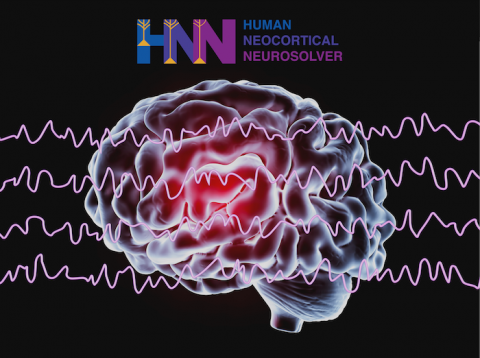 Human Neocortical Neurosolver (HNN) allows researchers and clinicians to uncover the brain circuits that generate the signals from electroencephalography (EEG) and magnetoencephalography (MEG) brain recordings. In a recent methods paper published in eLife, Jones and her collaborators explained how this easy-to-use interpretative tool could improve treatment for brain disease.
Human Neocortical Neurosolver (HNN) allows researchers and clinicians to uncover the brain circuits that generate the signals from electroencephalography (EEG) and magnetoencephalography (MEG) brain recordings. In a recent methods paper published in eLife, Jones and her collaborators explained how this easy-to-use interpretative tool could improve treatment for brain disease.
“HNN is designed to accurately account for the biophysics creating macro-scale human EEG/MEG signals, but with enough detail to link to the cellular and circuit activity,” said Jones, an associate professor of neuroscience who is affiliated with Brown’s Carney Institute for Brain Science. “HNN has the potential to be a widely accessible tool for translational neuroscience research that ultimately leads to novel methods to diagnose and treat human neuropathology.”
In the following Q&A, Jones explains how the idea for HNN stemmed from her doctoral thesis, and how her Ph.D. in mathematics gave her the foundation to use complex calculations to better understand the brain.
Q: What inspired you to create HNN?
As part of my graduate thesis, I developed simplified models of neural activity to describe how neural networks could create oscillations — such as brain rhythms — that remained stable to external perturbations. These simplified models were powerful because of their mathematically tractability.
During my postdoctoral studies in human neuroscience research at Massachusetts General Hospital, I began developing a more detailed model of neocortex that included multiple cell types, pyramidal neurons with dendrites and layer-specific information relay pathways. Inclusion of this level of biophysical detail led to new insights into the origin of human brain signals that were not possible in the simplified model.
In 2015, as part of President Obama’s BRAIN Initiative, the National Institutes of Health (NIH) announced a funding opportunity for “theories, models, and methods of analysis of complex data from the brain.” The call included the development of modeling tools for circuit level interpretations of human brain signals.
Community interest in our modeling framework had been growing, and we decided that the NIH call was the perfect opportunity to apply for funding to turn the model into a tool that could be accessible to the greater EEG/MEG community. The key to making it useful was to develop a graphical user interface to the underlying neural model, along with workflows of use, so that users could meaningfully interact with the model without needing neural modeling or coding experience. In 2018, the first version of our HNN software was released.
Q: What do you find to be the most exciting aspect of HNN, and what promise does it hold to human neuroscience?
We’re at a very exciting time in neuroscience discovery. New technologies to record from the human brain with techniques like EEG/MEG are rapidly advancing, as are new ways to store, share and analyze the data. At the same time, we’re experiencing a revolution in the ability to dissect cellular and circuit level activity with new techniques to genetically manipulate, record and modulate brain activity in animal models.
The most exciting aspect of HNN is its ability to translate across these scales and bridge the previously wide gap between human and animal research. HNN’s design allows for one-to-one comparison between human data and model output, while also providing detailed microcircuit dynamics over which the model predictions can be tested in animals. HNN can also be used to predict how these findings would translate to macro-scale human EEG/MEG signals.
Q: What is next for your HNN project?
Now that HNN is available, community adoption and feedback will be critical to its success. As such, current efforts are focused on engaging and training the community in the use of HNN. We are expanding our online training resources, holding domestic and international workshops, and working with several user groups to apply HNN to their research, including studies of pain, healthy and abnormal development, and non-invasive brain stimulation.
Based on initial feedback, we are also working to improve HNN’s utility in several domains, including expansion of model parameter estimation, inclusion of user defined models, and integration with MNE-python, an open-source localization software, so that users can both localize and interpret the neural origin of their data in one easy to use framework.
Q: How does your doctorate in mathematics influence your research at Carney?
My mathematics Ph.D. was fundamental to the creation of HNN, which at its core is a multi-dimensional system of coupled differential equations describing the electrical activity of a neural network.
My training in math, computer science and neuroscience allows me to work with an interdisciplinary group at Carney that includes students in the departments of neuroscience, applied mathematics and biomedical engineering. We are benefiting from the Carney space at 164 Angell Street and its collaborative ecosystem, which facilitates interactions among students and faculty in different departments working together in the field of computational neuroscience.
I’m also sensitive to the need to communicate and share advanced mathematical concepts with researchers of different backgrounds in order to make applied math tools transformative to neuroscience discovery.